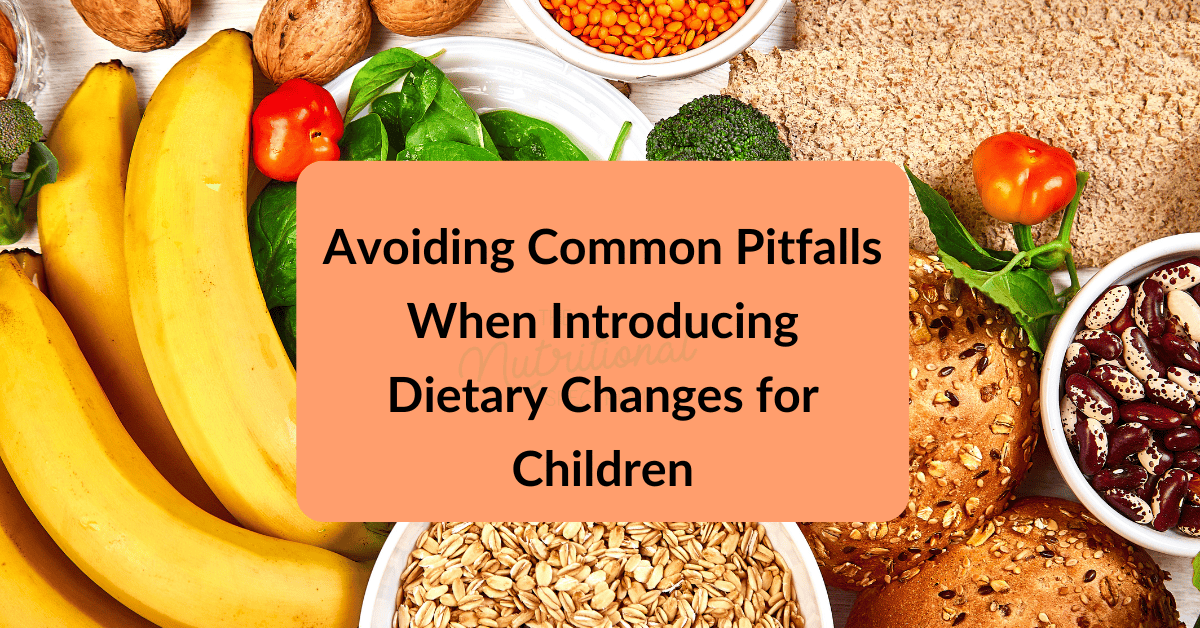Last updated on May 9th, 2024 at 04:30 am
Avoiding Common Pitfalls When Introducing Dietary Changes for Children
Starting a new diet plan with your kids is like going on an adventure into uncharted waters—it’s exciting to discover new things together, but a bit scary when you don’t know what’s ahead.
If you’re among the many parents who are considering or have already embarked on, the monumental task of transitioning your child to a different diet, you understand the complexity involved.
This could be due to concerns about your child’s well-being, ways to manage conditions like autism, or just a general desire to improve their nutrition.
Whatever the reason, it’s crucial to approach this new venture with knowledge, understanding, and of course, a hearty dose of patience.
In this blog post, I’ll guide you through common pitfalls for kids’ dietary changes, offering advice to create a seamless dietary transition for your child.
Why Children’s Diets Matter
 First and foremost, it’s essential to understand why dietary changes are more than just a passing trend—they are a foundation for a child’s health.
First and foremost, it’s essential to understand why dietary changes are more than just a passing trend—they are a foundation for a child’s health.
A balanced diet in childhood is key to not just physical growth, but also cognitive development, establishing long-lasting healthy eating patterns, and even influencing behavior.
For parents navigating the maze of modern dining options and health recommendations, this is no easy task.
Adjusting your child’s diet is not just a matter of changing the foods they eat; it’s a complete mind shift for the entire family.
It requires rethinking meal plans, grocery shopping, and even the way we talk about food, embodying a holistic approach to nutrition and well-being.
A Balanced Diet’s Impact on Development
Ensuring your child receives the requisite nutrients can have a profound impact on their life.
From bolstering immune systems to supporting strong bones and teeth, the list of benefits is extensive.
Disclosure: There are affiliate links in this post. If you click the link and buy something, I might get a commission at no additional cost to you! This is what keeps this blog running so consider using these links if you decide to try any of my recommendations.
Moreover, a diet high in processed sugars and unhealthy fats has been linked to a range of childhood issues, from hyperactivity to obesity.
The rise in conditions such as autism, ADHD, and developmental delays, has significantly influenced parental awareness and concern regarding dietary habits.
This increasing awareness has led more parents to scrutinize the food their children consume, understanding that diet can play a crucial role not only in managing symptoms but also in potentially improving overall behavioral and cognitive outcomes.
Recognizing this, health professionals often recommend dietary adjustments as part of a comprehensive approach to care, spotlighting the importance of nutrition in developmental health.
Common Dietary Transition Mistakes
Changing a child’s diet can come with its own set of small challenges. 
The most common pitfalls include making rapid, unprepared changes, following dietary fads without research, and failing to engage the entire family.
Avoiding Overcommitment
The Pitfalls of Rapid Changes
Rapid transitions, while seeming effective, can be disruptive and distressing for children.
It’s vital to protect their relationship with food, ensuring that changes are gradual and sustainable.
Introducing dietary changes too quickly can overwhelm both the child and the parent, leading to failure.
It’s better to aim for slow and steady progress, allowing your child to adjust and actively participate in the process, reducing stress for everyone involved.
Be Wary of Fad Diets
When it comes to children’s diets, there’s always a new trend on the horizon.
Many of these diets come with grand claims but lack the backing to prove their effectiveness for children, particularly in the long term.
Additionally, parents often undertake drastic dietary changes with enthusiasm, only to find that maintaining such strict guidelines is unsustainable.
The reality of busy family lives, social events, and the need for flexibility means that rigid diets are difficult to adhere to.
Furthermore, when parents don’t see immediate improvements or find the diet too challenging to keep up with, it can lead to disillusionment and abandonment of the dietary change altogether.
This not only disrupts the child’s dietary habits but can also lead to feelings of failure and frustration.
It’s important to set realistic expectations and remain adaptable, understanding that dietary changes are a marathon, not a sprint and that adjustments may be necessary along the way.
For those interested in exploring the impact of dietary changes on autism further, a recent study reviewing 13 therapeutic diets for autism provides insightful data and recommendations worth examining.
Understanding Dietary Trends
Blindly hopping onto the newest diet trend might result in a diet that’s not nutritionally balanced for your child’s needs.
It’s crucial to vet any new diet plan through the lens of your child’s specific nutritional requirements.
This underscores a particularly critical point: what works for one child might not work best for your child.
Each child’s body is unique, and their responses to different foods and dietary patterns can vary significantly.
Customization of dietary approaches, taking into account individual health needs, preferences, and reactions, is crucial for success.
The Importance of Family Support
The transition to a new diet is a family affair.
Without the support and participation of all family members, the chances of success diminish.
Always ensure that changes are made in an environment that promotes shared responsibility and support.
By involving the entire family in the process and making mealtime a positive family experience, you can foster a sense of togetherness and encourage your child’s progress.
Research Before You Revamp
Importance of Nutritional Research
Before revolutionizing meal times, invest time in understanding the different therapeutic diets and what might make one a good option for your child.
Nutrition is not a one-size-fits-all field, and different diets will suit different children.
Ensuring you have a solid basis of nutritional knowledge will empower your decisions and alleviate concerns.
Managing Expectations
Many parents fall into the trap of expecting immediate results. Nutrition is about long-term health, so setting realistic goals and milestones will help prevent discouragement.
Strategies for Smooth Dietary Changes
Now that we have identified the potential pitfalls, it’s time to lay out a roadmap for effective dietary transitions that will benefit your child in the long run.
Gradual Transitions for Success
Importance of Phased Approach in Diet Changes
Drive away from the fast lanes of dietary change and veer toward a gradual shift.
This will allow both you and your child to adjust to new flavors, textures, and routines at a comfortable pace.
Setting Achievable Milestones
Map out realistic milestones that are realistic for your child’s age and the challenges of daily life.
It could be increasing vegetable intake, cutting down on sugary snacks, or finding healthier alternatives to favorite junk foods.
These small wins will contribute to major success over time.
Involving the Whole Family
 Creating a Supportive Environment at Home
Creating a Supportive Environment at Home
The old adage ‘it takes a village to raise a child’ applies when altering diets.
Rally the family around the changes, so your child has a consistent experience at mealtimes, no matter who’s doing the cooking.
The Power of Routine
Mealtimes should be predictable.
Routine brings a sense of security to children and helps anchor changes in diet.
Create meal schedules and plans with which your child is comfortable and can anticipate.
Consistency is Crucial
Strategies for Maintaining Consistency
Life can be chaotic, but when it comes to your child’s diet, consistency is king.
Prepare in advance, stock up on essential food items, and keep a watchful eye on the intake to prevent backsliding into unhealthy patterns.
Long-term Benefits of Navigating Dietary Transition Mindfully
The investment you make in steering your child’s diet to calmer waters is enormous, but so are the potential returns.
With patience, preparation, and perseverance, you can establish healthy eating habits that will serve your child well into adulthood.
Remember, the values and habits you impart today could be crucial in shaping a future where your child celebrates not just a long life, but a vibrant and healthy one.
For those just beginning this transformative journey towards better health through diet, I invite you to take the first step with confidence.
Download my guide, “Taking the First Steps: A Roadmap for Initiating Dietary Changes,“ designed to provide you with the foundational knowledge and practical strategies needed to successfully navigate this transition.
Additional Resource:
- Check This Out If You Are Looking for More Helpful Resources
- Strategies for Children with Limited Diets
- Alternative treatments for Autism





0 Comments